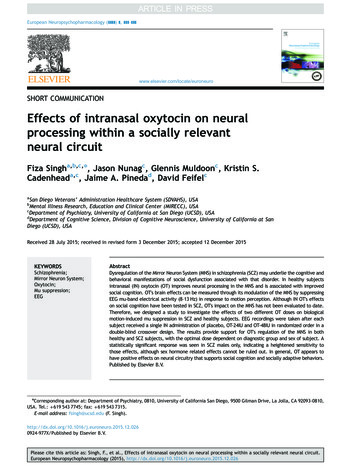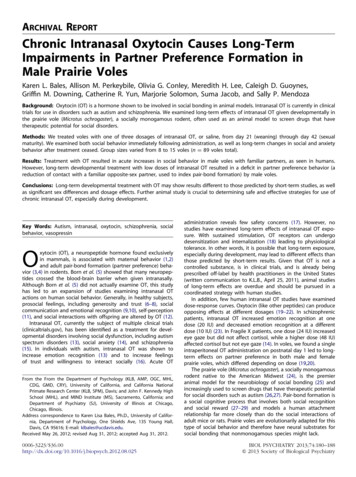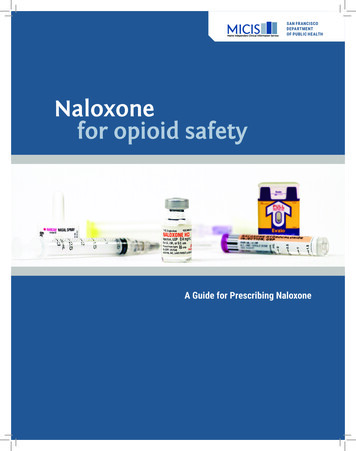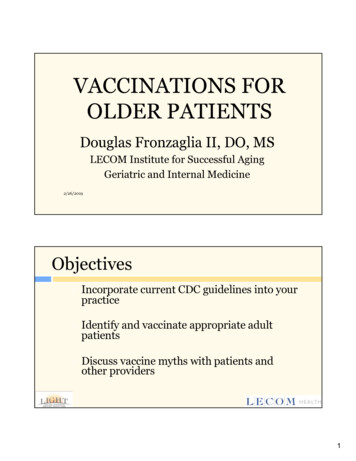
Transcription
European Neuropsychopharmacology (]]]]) ], ]]]–]]]www.elsevier.com/locate/euroneuroSHORT COMMUNICATIONEffects of intranasal oxytocin on neuralprocessing within a socially relevantneural circuitFiza Singha,b,c,n, Jason Nunagc, Glennis Muldoonc, Kristin S.Cadenheada,c, Jaime A. Pinedad, David FeifelcaSan Diego Veterans’ Administration Healthcare System (SDVAHS), USAMental Illness Research, Education and Clinical Center (MIRECC), USAcDepartment of Psychiatry, University of California at San Diego (UCSD), USAdDepartment of Cognitive Science, Division of Cognitive Neuroscience, University of California at SanDiego (UCSD), USAbReceived 28 July 2015; received in revised form 3 December 2015; accepted 12 December 2015KEYWORDSAbstractSchizophrenia;Mirror Neuron System;Oxytocin;Mu suppression;EEGDysregulation of the Mirror Neuron System (MNS) in schizophrenia (SCZ) may underlie the cognitive andbehavioral manifestations of social dysfunction associated with that disorder. In healthy subjectsintranasal (IN) oxytocin (OT) improves neural processing in the MNS and is associated with improvedsocial cognition. OT's brain effects can be measured through its modulation of the MNS by suppressingEEG mu-band electrical activity (8–13 Hz) in response to motion perception. Although IN OT's effectson social cognition have been tested in SCZ, OT's impact on the MNS has not been evaluated to date.Therefore, we designed a study to investigate the effects of two different OT doses on biologicalmotion-induced mu suppression in SCZ and healthy subjects. EEG recordings were taken after eachsubject received a single IN administration of placebo, OT-24IU and OT-48IU in randomized order in adouble-blind crossover design. The results provide support for OT's regulation of the MNS in bothhealthy and SCZ subjects, with the optimal dose dependent on diagnostic group and sex of subject. Astatistically significant response was seen in SCZ males only, indicating a heightened sensitivity tothose effects, although sex hormone related effects cannot be ruled out. In general, OT appears tohave positive effects on neural circuitry that supports social cognition and socially adaptive behaviors.Published by Elsevier B.V.nCorresponding author at: Department of Psychiatry, 0810, University of California San Diego, 9500 Gilman Drive, La Jolla, CA 92093-0810,USA. Tel.: 619 543 7745; fax: 619 543 7315.E-mail address: fsingh@ucsd.edu (F. 12.0260924-977X/Published by Elsevier B.V.Please cite this article as: Singh, F., et al., Effects of intranasal oxytocin on neural processing within a socially relevant neural circuit.European Neuropsychopharmacology (2015), http://dx.doi.org/10.1016/j.euroneuro.2015.12.026
2F. Singh et al.1.IntroductionThe Mirror Neuron System (MNS), a neural circuit comprisedof interconnections between inferior frontal cortex, inferiorparietal lobule and superior temporal sulcus is implicated insupporting social functioning (Iacoboni and Mazziotta, 2007).Recent emphasis on connecting neuropsychiatric disorderswith brain networks (Research Doman Criteria- RDoCs initiative) (Cuthbert and Insel, 2010; Singh and Feifel, 2013) hasgenerated interest in studying the MNS in disorders withprominent social cognition and behavioral deficits.Under controlled conditions, the MNS modulates 8–13 Hzoscillations over sensorimotor cortex (Keuken et al., 2011),such that exposing a subject to motion generated by abiological agent desynchronizes these baseline rhythms. Thisevent related desynchronization or “mu suppression” (MS) isconsidered an operational measure of MNS function (Singhet al., 2011; Ulloa and Pineda, 2007). One experimentalapproach to interrogate MNS involves presenting subjectswith point light animation videos (sparse visual representations of motion) that require filling in of context by thesubject in order for the animated object to be perceived.Videos with biological motion (e.g. a person running) elicitgreater MS than those with non-biological motion (e.g.moving circle) (Singh et al., 2011; Ulloa and Pineda, 2007).Social dysfunction is a core feature of schizophrenia(SCZ). Recent studies have shown that SCZ subjects withpoor social functioning exhibit weaker MS to biologicalmotion, but not to other stimuli (Mehta et al., 2014),suggesting that a dysregulated MNS may underlie the socialdysfunction of the disorder. Current antipsychotic drugs areunable to adequately reverse social dysfunction (KucharskaPietura and Mortimer, 2013), or MS abnormalities in SCZdespite demonstrated improvement in psychotic symptoms(Mitra et al., 2014). This underscores the need for treatments that regulate MNS activity in schizophrenia and otherdisorders associated with MNS dysfunction.Oxytocin (OT) is a neurohormone with important effectson social behavior in mammals, including increasing trust,reducing fear, improving theory of mind and social memory(Meyer-Lindenberg et al., 2011). OT appears to affectbiological motion detection (Keri and Benedek, 2009), andimproves MS as shown in a study by Perry et al. (2010), inwhich a single 24IU dose of intranasal (IN) OT enhanced MS tobiological motion in healthy controls (HC). Thus, it appearsOT may sharpen the detection of socially relevant stimuli viaregulation of the MNS. Though OT's effects on MNS function inSCZ patients has, thus far, not been directly investigated, wehypothesize that OT can remediate MNS dysregulation associated with this disorder. The current pilot study, therefore,investigated whether IN OT could enhance MS in response tobiological motion in SCZ patients. Since both previouslyreported studies tested only 24IU-OT, (Keri and Benedek,2009; Perry et al., 2010), we compared the effects of 24IUOT and 48IU-OT to explore whether higher doses inducegreater MS in HC and SCZ. The study was designed forefficient pilot testing using the National Institutes of MentalHealth (NIMH) ouncements/clinical-trials-foas/index.shtml) guidelines to support “go/no-go” decisions on whether a largerstudy is justified for rapid translation. This approach allowsfor pilot testing to obtain an estimate of effect size to designand implement adequately powered studies. Therefore, atotal of 32 subjects were recruited (detailed demographicinformation presented in the next section).2.2.1.Experimental proceduresParticipantsMen and women 18 years of age or older who met DSM-IV criteria forSCZ based on SCID interview were included. Subjects were on atherapeutic dose of an antipsychotic medication, with no changes inthe 4 weeks prior to testing and were at least moderately ill(severity scores on PANSS and CGI-S). The mean daily chlorpromazine equivalent dose for subjects' antipsychotics was 201.8 175.7 mg. A history of substance abuse or dependence in fullremission and negative urine toxicology at screening was allowedbut not other axis 1 disorders. HC subjects without any psychiatricdisorders were included.2.2.Medication administrationIn a randomized, double-blind, cross-over design, all participantswere pretreated with a single administration of IN placebo, lowdose OT (24IU) and high-dose OT (48IU) (compounded by UCSDinvestigational pharmacy) prior to viewing videos of biological andnon-biological motion. Subjects received each drug condition inrandomized order, separated by one OT-free week. Patients weremaintained on their pre-enrollment antipsychotic regimen. OT orplacebo was administered at t 0 and timer started for 45 min.During the first 10–15 min, EEG cap and electrodes were applied fortesting. Subjects remained in a quiet room free of social stimulationuntil five minutes prior to end of timer. At this time, subjects werealerted to the fact that testing would begin soon. Presentation andstimuli were cued and testing started at 45 min post OT administration in all subjects.2.3.EEG methodsAfter each IN medication administration a 32-electrode Biosemi EEGcap, 2 reference electrodes and 2 pairs of electrodes for eyemovement (EOG) monitoring was applied to the subject's scalp (10–20 system), mastoid processes and eye region, respectively.Subjects viewed 60–80 s videos of biological motion (personjumping rope), non-biological motion (rotating circle) and baselinecondition (two moving balls) presented in random order (Detaileddescription (Singh et al., 2011). Both EEG and EOG were digitallyamplified and sampled at 1024 Hz using the Biosemi Active IIsystem. EEG data were processed with Brain Vision Analyzer(www.brainproducts.com) using 0.5 Hz high-pass filter (24 dB),artifact removal (7100 μV oscillations and first and terminal 10 sof recording); Remaining artifact-free segment was used to compute mu power in 8–13 Hz frequency using Fast Fourier Transform(FFT). FFT was performed at 0.5 Hz intervals, 2048 pointsper segment using a Hanning window. EEG data from 1 HC and1 SCZ subject was not included in statistical analysis due to amechanical failure that precipitated incomplete data collection.EEG recordings from left (C3) and right (C4) sensorimotor cortexwere used to calculate MS for each condition using the equation:log 10 (mu power of experimental condition/mu power duringbaseline condition) (Oberman et al., 2007; Singh et al., 2011). Alog-transformed ratio was used to control for variability in absolutemu power due to individual differences in scalp thickness andelectrode impedance. Mu suppression social index (MSSI) wascalculated to obtain a quantitative measure that reflected OT'sPlease cite this article as: Singh, F., et al., Effects of intranasal oxytocin on neural processing within a socially relevant neural circuit.European Neuropsychopharmacology (2015), http://dx.doi.org/10.1016/j.euroneuro.2015.12.026
Effects of intranasal oxytocin on neural processing within a socially relevant neural circuitspecific effect on social motion processing (biological motion video)versus non-specific motion processing (non-biological motion video)by subtracting MS during non-biological condition from MS duringbiological motion condition. An MSSI41 represented greater effectin MS on social vs. non-social motion processing.2.4.Statistical analysisMSSI data were analyzed using repeated measures analysis ofvariance (RM-ANOVA) with treatment (placebo, 24IU OT or 48IUOT) and electrode site (C3, C4) as within-subject variables anddiagnostic group (HC, SCZ) and sex (male, female) as betweensubject variables. SPSS Version 22 was used to calculate η2 orCohen's d to obtain estimates of effect sizes for RM-ANOVAs ort-tests, respectively. Significant omnibus results were followed byappropriate post-hoc testing. Correlations between daily chlorpromazine equivalents (antipsychotic dose) and OT induced MSSI overleft and right sensorimotor cortex were investigated using parametric and non-parametric equations for each OT dose.3.3.1.Results and discussionDemographicsFifteen HC (6 Males, 9 females) and 17 SCZ subjects (9 Male,8 females) were enrolled. All subjects were able to selfadminister nasal spray after receiving instruction, andcompleted all three visits. The only side effect reportedwas nasal congestion in one subject after treatment thatresolved within 24 h. Sex ((χ2 (1, N 32) 0.290, p 0.6) andage (CTRL- 37 years715; SCZ- 47 years716 (t, 30 3.0,p 0.09)) were not significantly different between groups.SCZ subjects had significantly fewer years of education3(13.972; (t, 25 4.0, pr 0.01)), compared to HC (1771years of education), respectively.3.2.Data analysisThere was a significant three-way interaction betweentreatment sex diagnostic group (F (2, 54) 4.1,pr 0.05, η2 0.13]), but no main effect of treatment (F(2, 54) 1.9, p 0.16, η2 0.07) or electrode site (F (1, 27) 0.132, p 0.7, η2 0.01). Treatment sex diagnosticgroup interaction, followed up by 2 factor RM-ANOVAs(treatment diagnostic group) in males (F (2, 30) 2.2,p 0.1, η2 0.14]) and females (F (2, 24) 2.0, p 0.1,η2 0.13]) demonstrated medium effect sizes, though didnot reach significance. Similarly, 2 factor RM-ANOVA fortreatment sex in HC (F (2, 24) 1.6, p 0.2, η2 0.12) andSCZ subjects (F (2, 30) 2.7, p 0.08, η2 0.15) also demonstrated medium effect sizes, but was statistically nonsignificant. Exploratory single factor RM-ANOVAs were carried out to parse out treatment effects in HC males, SCZmales, HC females and SCZ females separately (Figure 1).These tests revealed a significant treatment effect in SCZmales (F (2, 16) 3.6, po0.05, η2 0.3) with a large effectsize. Single factor RM-ANOVAs in HC males (F (2, 8) 0.6,p 0.5, η2 0.15), HC females (F (2, 16) 2, p 0.2, η2 0.2)and SCZ females (F (2, 14) 1.1, p 0.4, η2 0.14), revealedmedium effect sizes, though did not reach statisticalsignificance. Follow-up paired samples t-tests in SCZ malescomparing placebo to 24IU (t (8) 1.0, p 0.3, Cohen'sd 0.4) and 48IU OT (t (8) 1.7, p 0.1, Cohen's d 1.3)revealed a large effect size at the higher dose, althoughFigure 1 Mu Suppression Social Index (MSSI) As a Function of Oxytocin Treatment: This graph illustrates change in MSSI in responseto single doses of IN Placebo, IN 24IU OT or 48IU OT in HC males, HC females, SCZ males and SCZ females.Please cite this article as: Singh, F., et al., Effects of intranasal oxytocin on neural processing within a socially relevant neural circuit.European Neuropsychopharmacology (2015), http://dx.doi.org/10.1016/j.euroneuro.2015.12.026
4F. Singh et al.statistical significance was not reached. Parametric correlations between daily chlorpromazine dose and OT inducedMSSI over left and right sensorimotor cortex, respectively,to placebo, (r(17) 0.12, p 0.6; r(17) 0.35, p 0.2),24IU OT (r(17) 0.09, p 0.7; r(17) 0.16, p 0.5) or48IU (r(17) 0.2, p 0.4; r(17) 0.26, p 0.3) did notreveal any significant correlations. Similarly, nonparametric correlations between antipsychotic dose andOT induced MSSI over left and right sensorimotor cortex,respectively, to placebo (rs(17) 0.04, p 0.9, rs(17) 0.2,p 0.4), 24IU OT (rs(17) 0.03, p 0.2, rs(17) 0.27,p 0.3) or 48IU OT (rs(17) 0.26, p 0.3, rs(17) 0.37,p 0.1) did not reach statistical significance.3.3.ConclusionsThis is the first study to compare the effect of different OTdoses on MS and the first to test the effects of OT on MS inindividuals with SCZ. The results suggest that single doses ofIN OT affect neural processing of socially-relevant information, and that the effects are influenced by gender anddiagnostic group. OT's enhancement of MSSI reached statistical significance in SCZ males only, suggesting that thissubgroup may be the most sensitive to OT's influence.Nonetheless, the lack of statistical significance in the othersubgroups must be viewed in context of the highly limitedpower produced by dividing the sample in four sex/diagnosissubgroups. The medium treatment effect sizes in the threesubgroups where treatment did not reach statistical significance supports the notion that small subgroup samplesize contributed to the lack of statistical significance.Perry et al. (2010) found that a single IN administration of24IU OT can improve MNS function in healthy males (Perryet al, 2010) and in our study that dose (24IU) also produced atrend toward increased socially specific MS, but 48IU was lesseffective, indicating that higher doses do not produce astronger effect (see Fig. 1). In contrast, healthy females'response trended towards greatest change in MSSI with 48IUOT indicating a lower sensitivity to OT-induced enhancementof MNS function. In SCZ subjects the dose-sex relationshipappears to be reversed, with women trending towardsgreatest biologically specific MNS facilitation in response to24IU-OT, whereas men had the strongest response to 48IU.3.4.vs. female, and premenopausal vs. postmenopausal womenmay also influence the presence and severity of SCZ symptoms. For instance, in premenopausal SCZ women, estrogensare associated with improved positive and negative symptoms (Heringa et al., 2015), whereas testosterone is associated with improved negative symptoms in SCZ males(Heringa et al., 2015). Additional considerations in womeninclude differential responsiveness of the OT system depending on the stage of a woman's menstrual cycle. This was notcontrolled in the present study; therefore, it is plausible thatdifferential EEG responses in the present study may havebeen modulated by sex hormones in addition to the influenceof OT treatment.In addition to sex specific effects, OT appears to havedifferential effects in clinical vs. healthy populations, suchthat clinical samples with pretreatment MNS deficits show agreater response than healthy subjects with intact MNSfunction. This is consistent with other findings, for example,IN OT improved subjective stress response and cortisollevels in a stress paradigm only in those subjects who hadreduced coping and emotion regulation abilities, but not insubjects with normal function in these domains (Kanatet al., 2014). Similarly, IN OT had no effect in subjectswith normal pretreatment empathic accuracy but improvedempathic accuracy in less socially proficient individuals(Kanat et al., 2014).Thus, the present study supports the growing body ofliterature on OTs differential brain effects. IN OT appears toincrease socially-specific MS in SCZ subjects, particularlymales, and therefore, provides preliminary support for thenotion that it can remediate deficits in MNS-mediated socialprocessing, in contrast to established antipsychotics (Mitraet al, 2014). Several studies have reported that IN OTenhances social cognition in patients with SCZ (Kanatet al., 2014)and enhancement of MNS function may underliethat effect. Limitations of this study include a small samplesize, which limits the generalizability of our results. Building upon this work, additional studies with larger samplesizes will need to explore the effects of chronic OTadministration on MNS function, social cognition and sociallyadaptive behaviors in disorders with social deficits. Specialattention will need to be focused on effects of sex andendogenous sex hormone concentrations and their potentialadditive antipsychotic effects on OT.DiscussionOT appears to influence men and women differently at thelevel of brain function and behavioral response. For instance,OT administration increases amygdala activation in women(Kanat et al., 2014; Riem et al., 2011; Rupp et al., 2014), butdecreases it in men. In a small sample of patients withgeneralized anxiety disorder, men showed decreased anxiety with 3-week OT treatment, whereas women showedincreased levels of anxiety (Olff et al., 2013). Differentialresponses to OT in men and women are particularly interesting, since women have higher prevalence of anxiety disorders(Schulte-Ruther et al., 2008), whereas men are at higher riskfor autism and schizophrenia (Kanat et al., 2014) perhaps dueto structural and anatomical differences in male and femalemirror-neuron regions (Cheng et al., 2009). In addition,varying concentrations of endogenous sex hormones in maleConflict of interestDr. Singh, Mr. Nunag, Ms. Muldoon, Dr. Cadenhead, Dr. Pineda andDr. Feifel have no conflicts of interest.ContributorsDr. Singh contributed to study design, data collection, data analysisand manuscript writing. Mr. Nunag assisted with data collectionand EEG analysis. Ms. Muldoon assisted with EEG data analysis.Dr. Cadenhead contributed to study design and manuscript editing.Dr. Pineda contributed to EEG data analysis and interpretation andmanuscript editing. Dr. Feifel contributed to study design, statistical analysis and manuscript editing. All authors have reviewed andapproved the final manuscript.Please cite this article as: Singh, F., et al., Effects of intranasal oxytocin on neural processing within a socially relevant neural circuit.European Neuropsychopharmacology (2015), http://dx.doi.org/10.1016/j.euroneuro.2015.12.026
Effects of intranasal oxytocin on neural processing within a socially relevant neural circuitRole of funding sourceThe Brain and Behavior Foundation's Young Investigator Awardprovided funds for study medication and subject payments. American Psychiatric Foundation's Early Career Investigator Award provided salary support for Dr. Singh. The funding source did not haveany role in study design, data collection, analysis and interpretationof data, writing of the report or in the decision to submit the articlefor publication.AcknowledgmentThis work was supported by the Brain and Behavior Foundation'sYoung Investigator Award and American Psychiatric Foundation'sEarly Career Investigator Award to Dr. Singh.ReferencesCheng, Y., Chou, K.H., Decety, J., Chen, I.Y., Hung, D., Tzeng, O.J.,Lin, C.P., 2009. Sex differences in the neuroanatomy of humanmirror-neuron system: a voxel-based morphometric investigation. Neuroscience 158, 713–720.Cuthbert, B.N., Insel, T.R., 2010. Toward new approaches topsychotic disorders: the NIMH Research Domain Criteria project.Schizophr. Bull. 36, 1061–1062.Heringa, S.M., Begemann, M.J., Goverde, A.J., Sommer, I.E., 2015.Sex hormones and oxytocin augmentation strategies in schizophrenia: a quantitative review. Schizophr. Res., 603–613.Iacoboni, M., Mazziotta, J.C., 2007. Mirror neuron system: basicfindings and clinical applications. Ann. Neurol. 62, 213–218.Kanat, M., Heinrichs, M., Domes, G., 2014. Oxytocin and the socialbrain: neural mechanisms and perspectives in human research.Brain Res. 1580, 160–171.Keri, S., Benedek, G., 2009. Oxytocin enhances the perception ofbiological motion in humans. Cogn. Affect. Behav. Neurosci. 9,237–241.Keuken, M.C., Hardie, A., Dorn, B.T., Dev, S., Paulus, M.P., Jonas,K.J., Den Wildenberg, W.P., Pineda, J.A., 2011. The role of theleft inferior frontal gyrus in social perception: an rTMS study.Brain Res. 1383, 196–205.Kucharska-Pietura, K., Mortimer, A., 2013. Can antipsychoticsimprove social cognition in patients with schizophrenia? CNSDrugs 27, 335–343.Mehta, U.M., Thirthalli, J., Aneelraj, D., Jadhav, P., Gangadhar,B.N., Keshavan, M.S., 2014. Mirror neuron dysfunction in5schizophrenia and its functional implications: a systematicreview. Schizophr. Res. 160, 9–19.Meyer-Lindenberg, A., Domes, G., Kirsch, P., Heinrichs, M., 2011.Oxytocin and vasopressin in the human brain: social neuropeptides for translational medicine. Nat. Rev. Neurosci. 12,524–538.Mitra, S., Nizamie, S.H., Goyal, N., Tikka, S.K., 2014. Unchangingmirror neuron activity in schizophrenia patients over 4 weeks oftreatment: evidence from a 192 channel quantitative electroencephalography study. Biol. Psychiatry 76, e13–e14.Oberman, L.M., Pineda, J.A., Ramachandran, V.S., 2007. Thehuman mirror neuron system: a link between action observationand social skills. Soc. Cogn. Affect. Neurosci. 2, 62–66.Olff, M., Frijling, J.L., Kubzansky, L.D., Bradley, B., Ellenbogen,M.A., Cardoso, C., Bartz, J.A., Yee, J.R., van Zuiden, M., 2013.The role of oxytocin in social bonding, stress regulation andmental health: an update on the moderating effects of contextand interindividual differences. Psychoneuroendocrinology 38,1883–1894.Perry, A., Bentin, S., Shalev, I., Israel, S., Uzefovsky, F., Bar-On, D.,Ebstein, R.P., 2010. Intranasal oxytocin modulates EEG mu/alpha and beta rhythms during perception of biological motion.Psychoneuroendocrinology 35, 1446–1453.Riem, M.M., Bakermans-Kranenburg, M.J., Pieper, S., Tops, M.,Boksem, M.A., Vermeiren, R.R., van Ijzendoorn, M.H., Rombouts, S.A., 2011. Oxytocin modulates amygdala, insula, andinferior frontal gyrus responses to infant crying: a randomizedcontrolled trial. Biol. Psychiatry 70, 291–297.Rupp, H.A., James, T.W., Ketterson, E.D., Sengelaub, D.R., Ditzen,B., Heiman, J.R., 2014. Amygdala response to negative imagesin postpartum vs nulliparous women and intranasal oxytocin.Soc. Cogn. Affect. Neurosci. 9, 48–54.Schulte-Ruther, M., Markowitsch, H.J., Shah, N.J., Fink, G.R.,Piefke, M., 2008. Gender differences in brain networks supporting empathy. Neuroimage 42, 393–403.Singh, F., Feifel, D., 2013. Developing Research Domain Criteria(RDoC) to improve diagnosis and treatment of social deficits inpsychiatric disorders: the Mirror Neuron System as a model.Schizophr. Res. 151, 293–294.Singh, F., Pineda, J., Cadenhead, K.S., 2011. Association ofimpaired EEG mu wave suppression, negative symptoms andsocial functioning in biological motion processing in first episodeof psychosis. Schizophr. Res. 130, 182–186.Ulloa, E.R., Pineda, J.A., 2007. Recognition of point-light biologicalmotion: mu rhythms and mirror neuron activity. Behav. BrainRes. 183, 188–194.Please cite this article as: Singh, F., et al., Effects of intranasal oxytocin on neural processing within a socially relevant neural circuit.European Neuropsychopharmacology (2015), http://dx.doi.org/10.1016/j.euroneuro.2015.12.026
SHORT COMMUNICATION Effects of intranasal oxytocin on neural processing within a socially relevant neural circuit Fiza Singha,b,c,n, Jason Nunagc, Glennis Muldoonc, Kristin S. Cadenheada,c, Jaime A. Pinedad, David Feifelc aSan Diego Veterans' Administration Healthcare System (SDVAHS), USA bMental Illness Research, Education and Clinical Center (MIRECC), USA










